Board meetings are structured discussions that shape the future of an organization. To successfully manage them, the chairs, directors, and administrators must master the art of board meeting protocols. The productivity of a board meeting hinges on the effectiveness of these protocols, which foster more focused discussions, informed decisions, and clearly defined actions.
Want to learn how to hold a board meeting like a pro? Use this comprehensive guide to board meeting protocols. Explore its different components and discover how it can help foster more productive and open board meetings.
What is a board meeting protocol?
Board meeting protocol is a compilation of rules, procedures, and etiquette that governs directors and members during board meetings. Promoting a structured approach, its implementation helps amplify accountability, transparency, and internal controls among directors. With defined guidelines, board meeting protocols empower the board to conduct timely, impartial, and orderly discussions.
There is no definite format for board meeting protocols, as they vary per organization. However, generally, it must serve a clear overarching purpose: guiding the board toward informed decision-making and strategic guidance.
There are three components to a board meeting protocol:
- Board meeting rules: These are standard policies board members should observe during official meetings, such as quorum, voting protocols, and conflict of interest management.
- Board meeting etiquette: This outlines the ideal conduct of directors at meetings. As stewards of leadership, it demands that directors respect diverse viewpoints, avoid personal attacks, and maintain confidentiality.
- Board meeting procedure: This outlines the proper sequence of tasks involved in meeting management, from the pre- to post-meeting. It provides the board with step-by-step guidance on agenda creation, meeting notifications, document distribution, and vote facilitation.
Factors Influencing Board Meeting Protocols
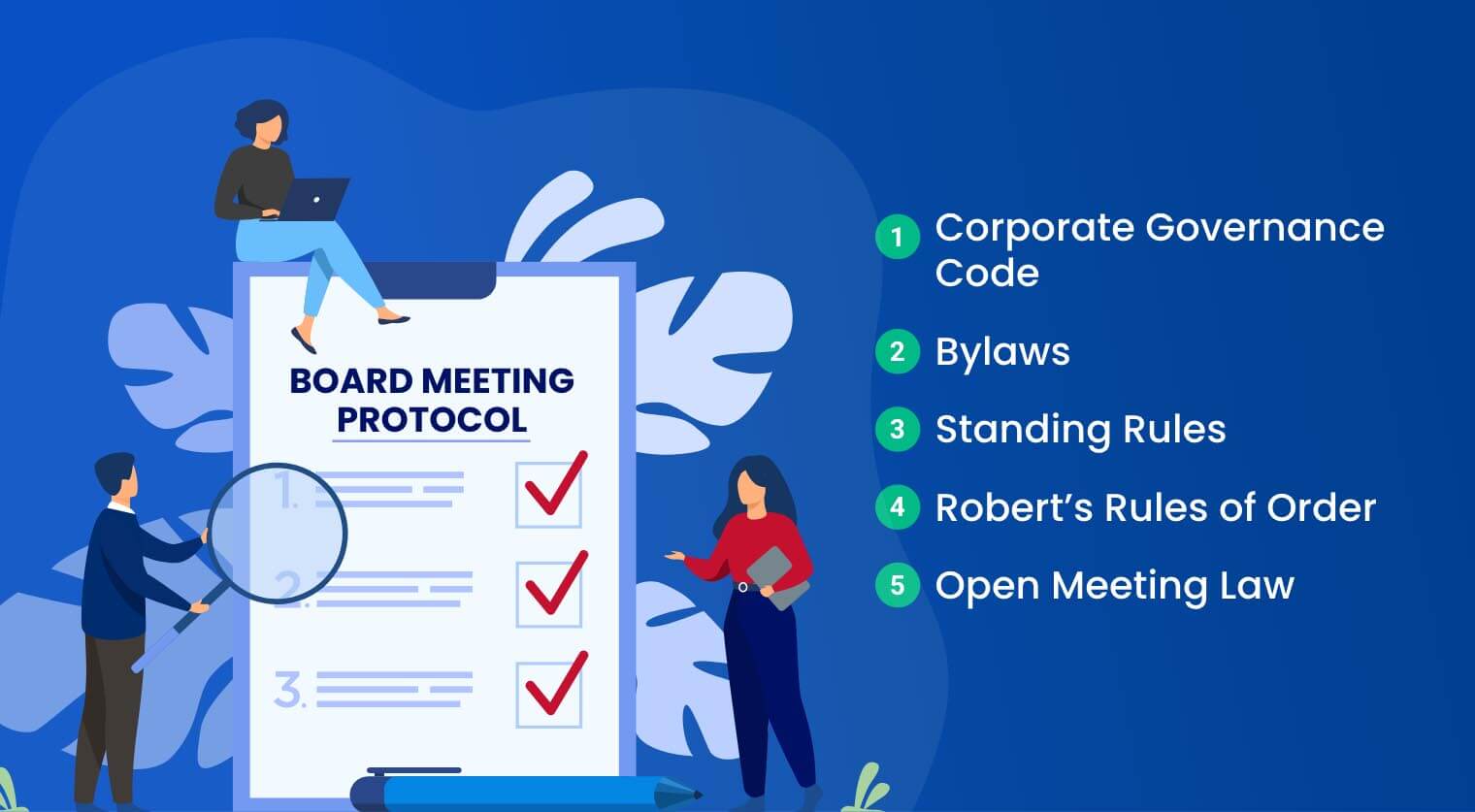
Internal and external regulations are big factors in board meeting protocols. Organizations must carefully consider them to ensure their protocols align with legal requirements, industry standards, and internal policies.
Here are some of the key factors to consider when crafting a comprehensive board meeting protocol.
1. Corporate Governance Code
Countries enforce their own Corporate Governance Code to promote responsible board governance by outlining core aspects such as the roles of directors, board composition, shareholder engagement, risk management, and ethical conduct. Consisting of provisions on leadership best practices, it serves as a benchmark for organizations to achieve good governance, transparency, accountability, and sustainable growth.
The United Kingdom, for example, created a model for corporate governance code with its “comply or explain” policy. The policy offers flexibility, allowing organizations to either follow the recommendations or choose a different approach, as long as they explain their rationale. The United States takes a more prescriptive approach. While they don’t have a formal Corporate Governance Code, organizations interrelate various regulations and laws to strengthen their corporate governance. These include state corporate law, federal securities law, stock exchange listing rules, and industry-specific regulations.
2. Bylaws
Bylaws serve as the primary rulebook for organizations. It lays out a governance framework directing how leaders can govern members, employees, and shareholders across different situations. As the basis of all internal regulations, bylaws detail fundamental details on the location, purpose, board members and election, membership, committee composition, finance audit, and amendments.
3. Standing Rules
Standing rules of board meetings are administrative laws that guide the board of directors in managing day-to-day operations. Created to make meetings more orderly, standing rules address specific procedures not covered by bylaws. It typically includes policies for notice requirements, seating arrangements, recordkeeping, committee operations, and voting procedures.
4. Robert’s Rules of Order
This is a compilation of parliamentary procedures organizational leaders use to facilitate productive and fair deliberations. It recommends a systematic approach to meetings, detailing guidelines for passing motions, rules for debate, and methods for amendment. In 2022, Robert’s Rules of Order reached its 12th edition, featuring new provisions for debating nominations and improved clarity and accessibility in the rules.
At its core, Robert’s Rule of Order is grounded on these principles:
- All members have equal rights, privileges, and obligations to ensure fairness within the group.
- A quorum or majority of members is required to conduct official business.
- All actions taken during meetings must be formally proposed and approved through motions.
5. Open Meeting Law
Open meeting laws require government offices and public bodies to conduct their affairs openly, allowing the public to attend meetings and access records and decisions. To comply, organizations must encourage participation by notifying the public of meetings on time, selecting accessible venues, and welcoming input. Public bodies that fail to meet the requirements may face legal consequences, including invalidation of actions, fines, penalties, legal disputes, mandatory training, and negative public perception.
Step-by-Step Guide on How to Conduct a Board Meeting
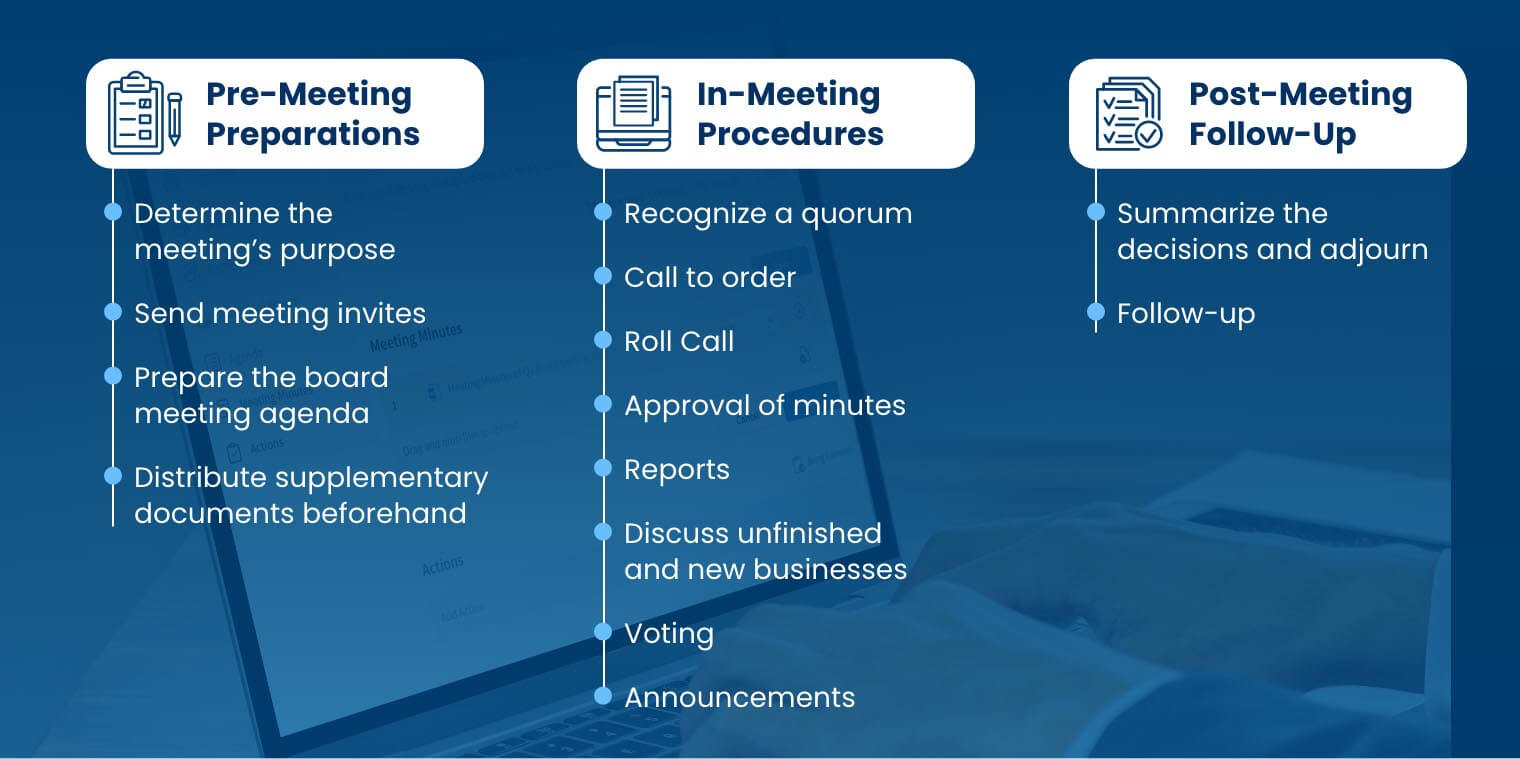
While it may be too complex to conduct board meetings because of the regulations and laws that surround them, it is necessary to follow specific board of directors meeting rules and procedures. To help you excel at your next meeting, here’s a step-by-step guide:
Pre-Meeting Preparations
The synergy between directors and administrators is crucial when preparing for a board member meeting. Organizing a meeting begins with priming the board with pre-meeting information to help them understand the meeting’s goals and objectives.
For pre-meeting preparations, the board and administrators should:
- Determine the meeting’s purpose: Before building the agenda and invites, the chair must identify the goals and objectives for the meeting.
- Send meeting invites: Select the most suitable time slot and create a meeting invitation for directors. Indicate the time, location, and purpose.
- Prepare the board meeting agenda: Collect all discussion points and arrange them to build an agenda. Ensure that each topic aligns with and contributes to achieving the targets.
- Distribute supplementary documents beforehand: Send supporting documents with or after the meeting invitation. Providing them before the meeting gives directors ample time to review the materials and prepare their comments for discussion.
In-Meeting Procedures
Meeting facilitation is just as crucial as preparation. For productive discussions, the board must adhere to the Order of Business. Highly influenced by Robert’s Rules of Order, it typically proceeds as follows:
- Recognize a quorum: Verify if the number of attendees makes a quorum before proceeding to the agenda.
- Call to order: Have the presiding officer or board chair call to order on time.
- Roll Call: The presiding officer must then call on each board member to take attendance. This procedure ensures proper recording of attendees and allows the board to make last-minute adjustments.
- Approval of minutes: Have the board review the previous meeting’s minutes. The board must notify the chair of any corrections before officially approving the minutes.
- Reports: Give sufficient time for presenters to take the stage and discuss their reports. These may include reports on board committees, finances, or other relevant progress updates.
- Discuss unfinished and new businesses: Revisit the task lists from the previous meeting and ask task owners for updates to keep progress on track. Following this, the board can open the discussion for upcoming projects in the pipeline or initial proposals.
- Voting: After discussions, the officiator will facilitate the voting for specific matters that require decisions. The board typically votes via voice vote, a show of hands, or e-voting.
- Announcements: Before formally closing the meeting, allocate time for sharing announcements and upcoming events relevant to the board.
Post-Meeting Follow-Up
Meeting workflows don’t end once the meeting is over. To ensure that all assigned tasks will move forward, the board must:
- Summarize the decisions and adjourn: The board should prepare a summary of all decisions and task outlines before adjourning the meeting.
- Follow-up: For visibility and transparency, directors must receive the minutes, action items, and follow-up tasks after the meeting.
Board meetings are meticulous to mount, from preparation to execution. While traditional methods remain common, integrating technology offers a more efficient and long-term solution. The advent of board portal software has significantly streamlined the meeting workflow, making the process smoother and more manageable for directors and administrators.
Besides, you don’t have to create your meeting protocols from scratch! Use our Robert’s Rules cheat sheet to create a comprehensive board meeting protocol template tailored to your organization. Click the banner below to download.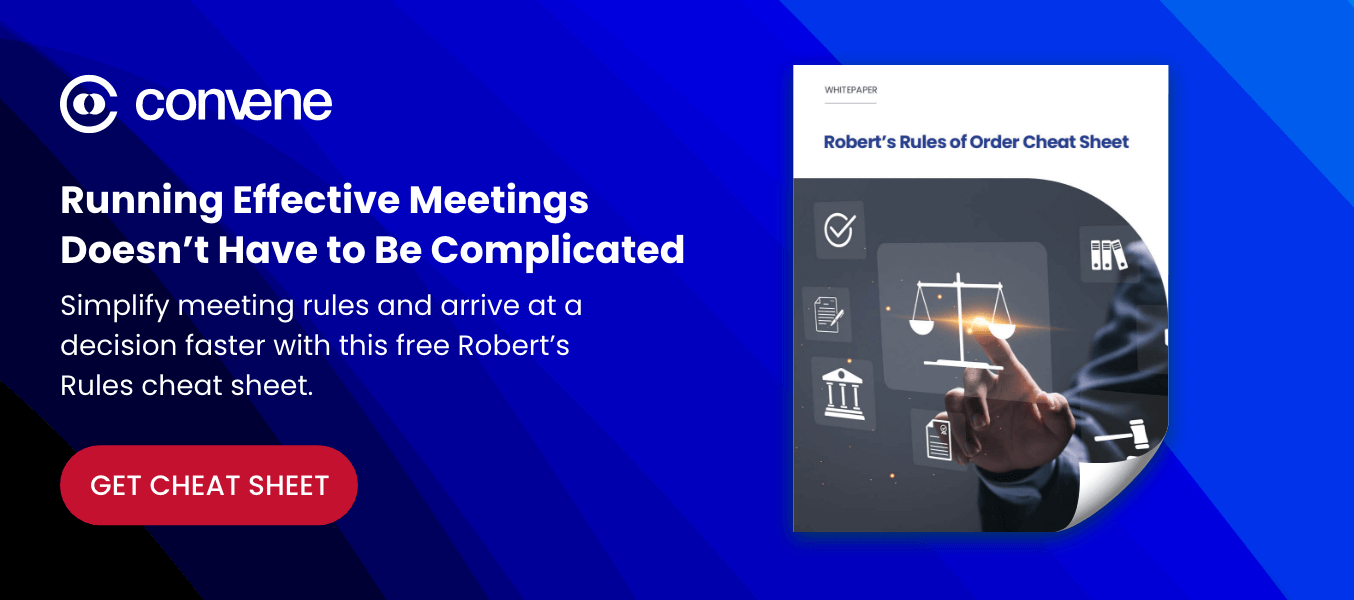
What are the common mistakes in board meetings?
Mistakes are inevitable, but they can be avoided in board meetings with an effective board meeting protocol. Listed below are the common pitfalls in board meetings to help you navigate around them.
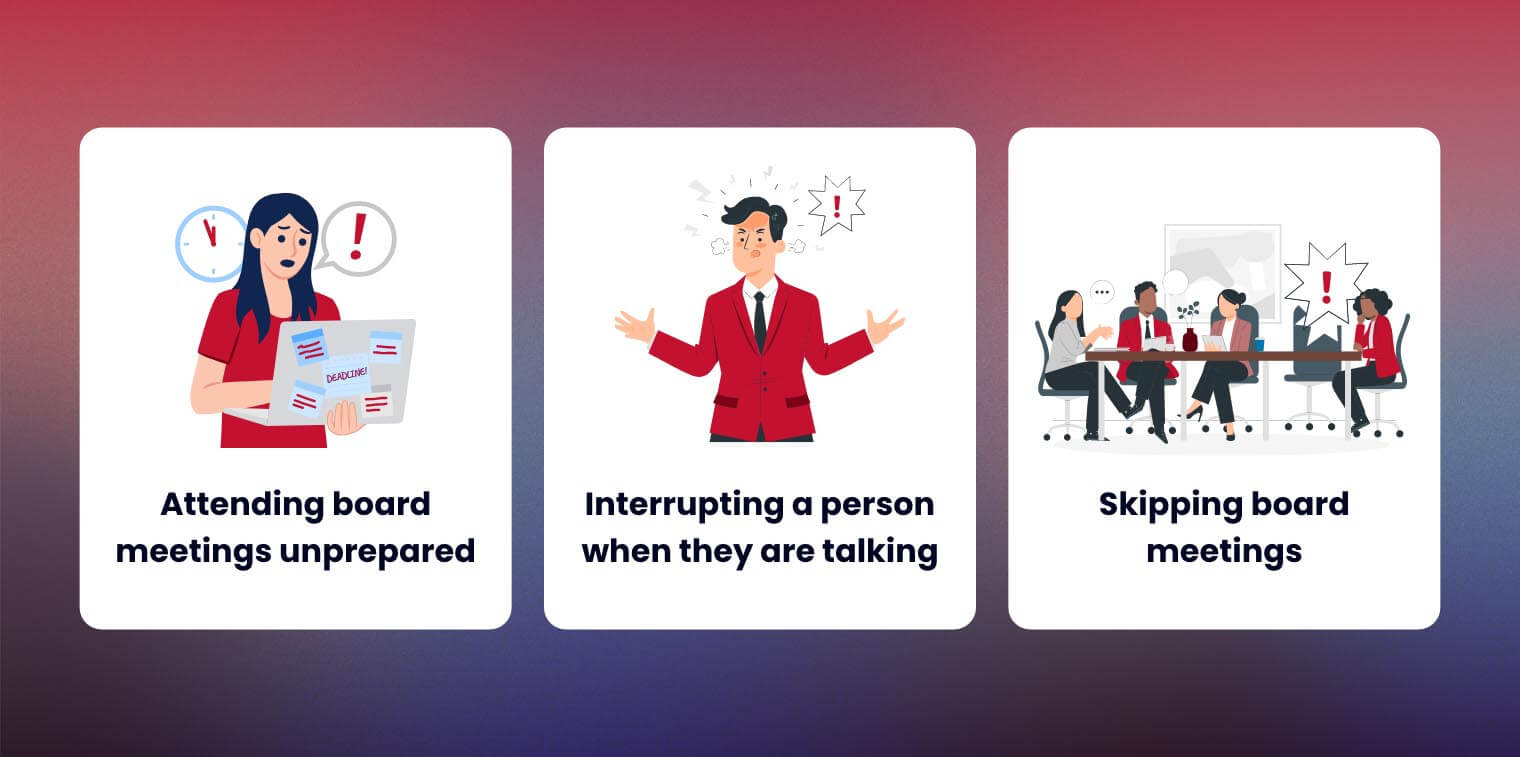
1. Attending board meetings unprepared
Board members must be well-prepared before attending board meetings. Making an effort to review documents and study topics demonstrates a commitment to the role, boosting board members’ confidence in one another. This helps them earn respect, leading to more collaborative decision-making.
2. Interrupting a person when they are talking
Board members discuss high-level management matters crucial for steering the organization toward sustainability and growth. Given the significance and complexity of their agendas, board members often debate over decisions, making the meetings intense. Although challenging, these debates are a healthy part of decision-making, provided everyone follows the meeting protocol. This is where board meeting etiquette becomes invaluable. It establishes boundaries and provides a fairer opportunity for everyone to share their insights, preventing interruptions and other disrespectful behaviors.
3. Skipping board meetings
It is the core duty of board members to be active in meetings. Running meetings with insufficient board members won’t make a quorum, making the discussion counterproductive. To avoid this, there should be a specific provision in the board meeting protocol about quorum and the required attendance of board members.
Board Meeting Etiquette Tips
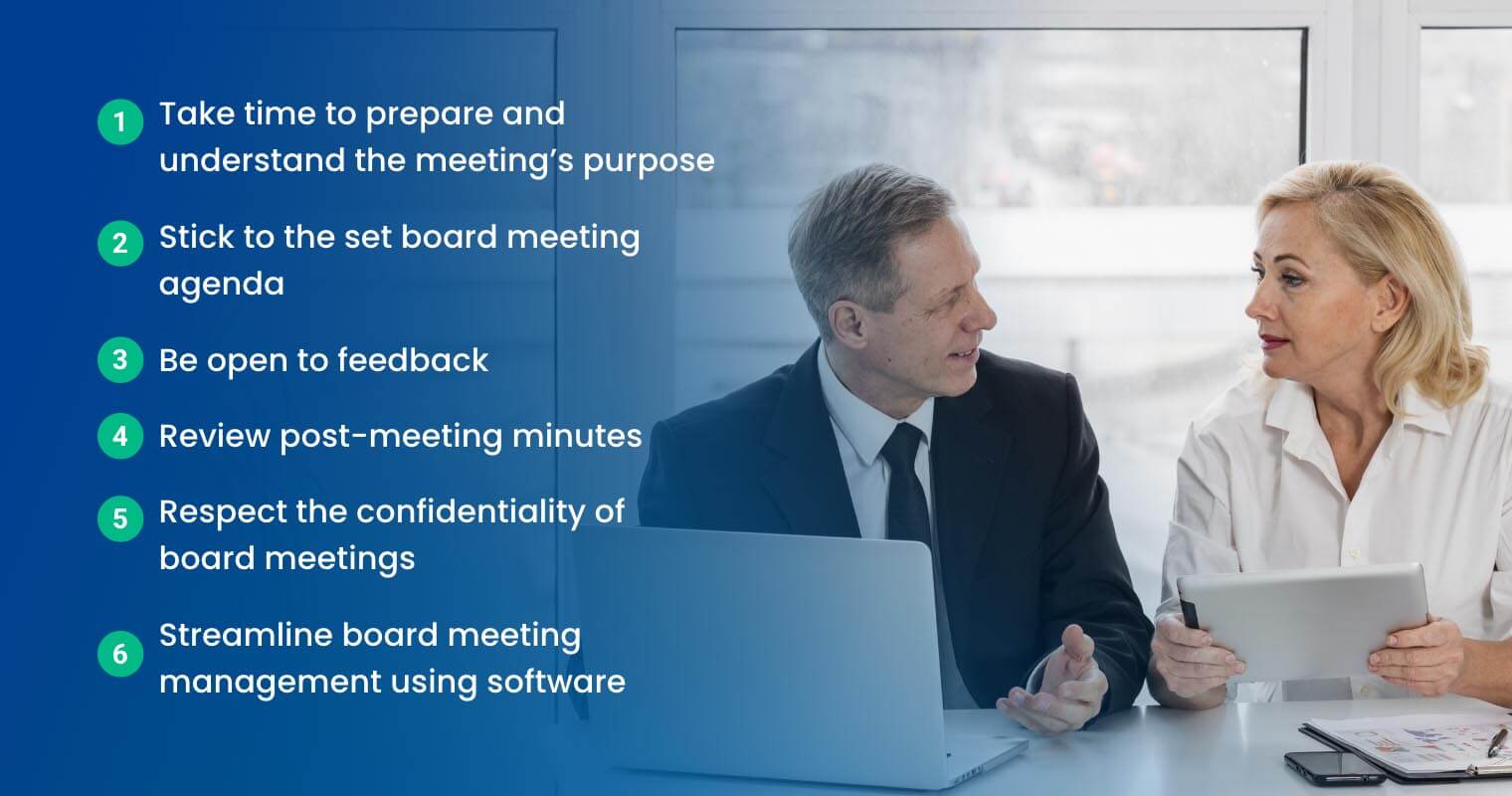
Board meeting protocols not only require rules and procedures for effective communication but also professionalism and respect from members. To maintain a positive impression, mastering proper meeting etiquette is essential. Here are some best practices directors should keep in mind when attending board meetings:
1. Take time to prepare and understand the meeting’s purpose
Attend a board meeting with a clear understanding of its purpose and objectives. By coming to meetings prepared, individuals can contribute meaningfully to discussions and offer more relevant recommendations. Preparation typically involves reviewing the key issues, proposed solutions, and financial implications of each agenda item. Additionally, conducting independent research on relevant topics can provide valuable insights and foster informed discussions.
2. Stick to the set board meeting agenda
Time is of the essence, especially for high-level executives like the board of directors. It is best practice to respect the structure provided on the agenda to avoid discussions about unnecessary topics. Instilling such discipline ensures that all critical issues are covered within the allocated time, making meetings more efficient and productive.
3. Be open to feedback
Constructive criticism is vital for the improvement and growth of the board and the organization as a whole. Everyone in meetings – directors, committee officers, or employees – must be open to giving and receiving feedback. To achieve this, the board has to foster a safe and respectful environment where ideas can be shared freely without judgment or retaliation.
4. Review post-meeting minutes
Directors must be fully aware of their responsibilities, both during and outside meetings. Monitoring progress and tasks involves carefully reviewing meeting minutes. This helps reinforce accountability and keeps key stakeholders informed of everyone’s contributions. Additionally, reviewing meeting minutes helps directors prepare for the next session.
5. Respect the confidentiality of board meetings
Sharing and discussing sensitive information is common in boardrooms. Confidentiality among board members is crucial to protecting all information shared during discussions. Doing so fosters trust among stakeholders and safeguards the organization’s interests.
6. Actively contribute and participate
Active participation from board members leads to more productive meetings. Directors must be open to sharing their viewpoints and submitting votes promptly to maintain meeting momentum. Boards can consider implementing board portal software to bolster engagement, especially in remote meetings. This tool provides secure and easy access to board documents, enabling members to locate relevant files quickly. It also facilitates good timekeeping and offers a streamlined process for e-voting, significantly enhancing member participation and overall meeting efficiency.
Frequently Asked Questions on Board Meeting Protocol
Dive deeper into board meeting protocol with these FAQs.
What is a quorum?
A quorum refers to the minimum number of members required at a given meeting to make the session official. If a meeting fails to reach a quorum, decisions passed during the deliberation are considered null. The requirements of quorum are often stipulated in an organization’s bylaw. There is no uniform standard for a quorum, but it is common practice among organizations to have it at a simple majority. For example, a board with ten directors will need six directors to complete a quorum.
How does the board chair maintain order and decorum during meetings?
The board chair guides the board to meet its objectives by facilitating orderly and fair meetings. To ensure directors maintain proper decorum in meetings, they are responsible for the following:
- Setting the tone: The chair is responsible for setting a positive and open meeting atmosphere to boost directors’ participation. They achieve this by creating clear goals and expectations, promoting collaborative discussion, and ensuring respectful deliberations.
- Enforcing rules and regulations: The chair is vested with the authority to implement protocols and procedures to govern the behavior of directors in meetings.
- Modeling appropriate behavior: A chair must lead by example. Demonstrating proper conduct in board meetings fosters professionalism among all directors, leading to more fruitful and positive collaborations.
Can the board hold an informal meeting?
Yes, informal meetings are typically organized for less important agendas, such as sharing knowledge, discussing minor projects, and building relationships with one another. These meetings follow looser protocols, unlike official meetings that have a structured flow.
Transform Your Board Meeting with Convene’s Meeting Portal
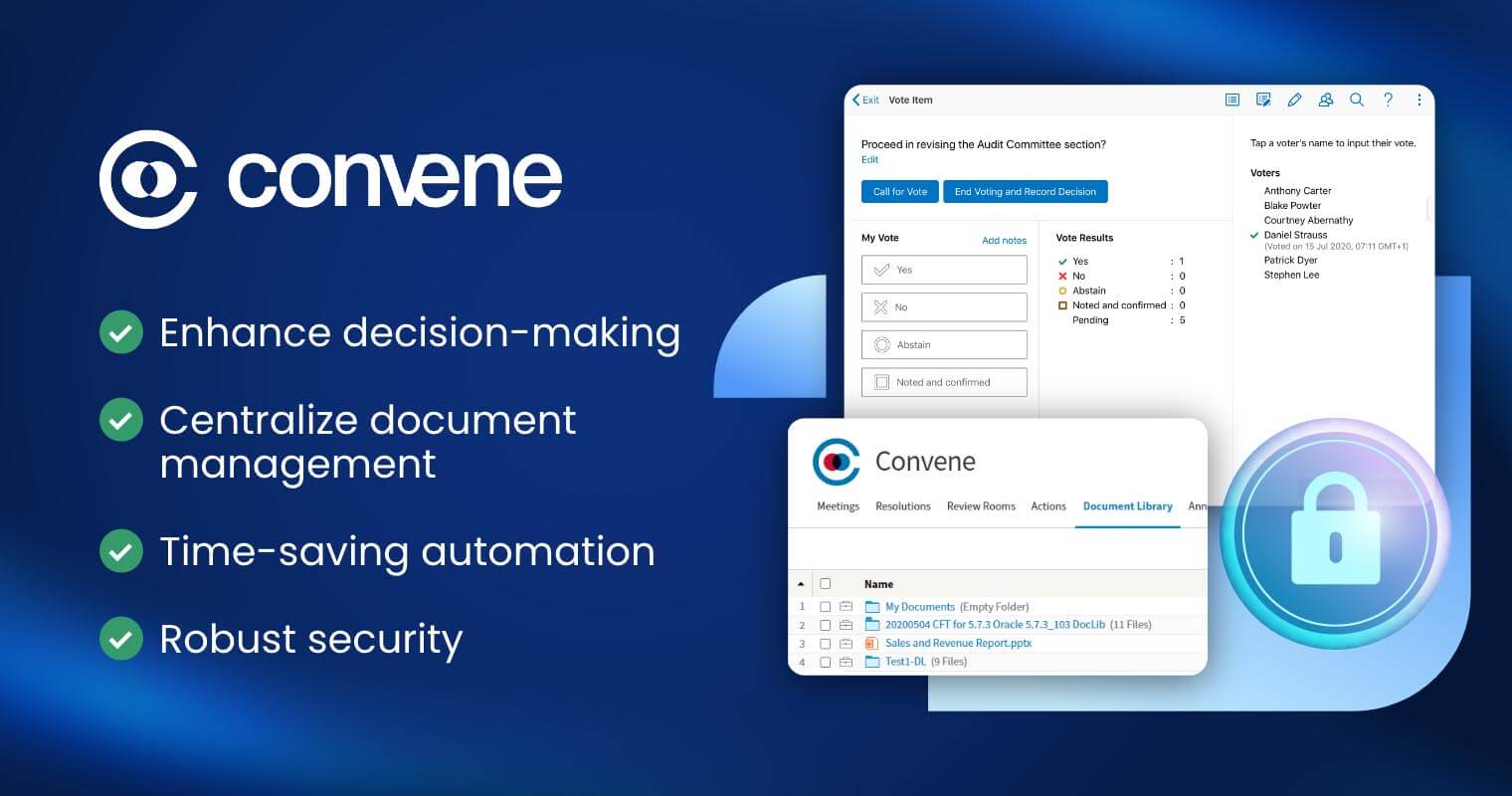
Organizing meetings doesn’t have to be daunting, especially when equipped with the right tools and strategies! This is where board portal software comes into play, transforming the way meetings are managed.
Introducing Convene, a leading board portal software designed to streamline meeting management, enhance collaboration among directors, and elevate board efficiency. Our platform breaks down the complexity of meeting protocols, promoting better compliance and productivity among directors.
What else can Convene do for you?
- Enhance decision-making: You don’t need to worry about decision-making inside and outside meetings. Convene has a voting function directors can utilize to circulate voting options and capture responses efficiently. This ensures that all voices are heard and decisions are made transparently.
- Centralize document management: Make board documents quickly accessible to directors with Convene. The digital platform serves as a secure storage for essential materials that directors require when making decisions, accelerating the process.
- Time-saving automation: Schedule meetings and build agendas in less time than usual. Maximize the board’s time by automating recurring tasks so they can focus on strategic planning, improving overall productivity.
- Robust security: Ensure no sensitive data leaks from the board! Protect them with a board portal that has stringent security measures. Convene has advanced encryption protocols, secure access controls, and comprehensive audit trails to safeguard your confidential information.
Ready to elevate your board meetings and streamline your processes? Schedule a meeting with us to discover how Convene can help you achieve more productive, organized, and secure meetings.
Jean is a Content Marketing Specialist at Convene, with over four years of experience driving brand authority and influence growth through effective B2B content strategies. Eager to deliver impactful results, Jean is a data-driven marketer who combines creativity with analytics. In her downtime, Jean relaxes by watching documentaries and mystery thrillers.









